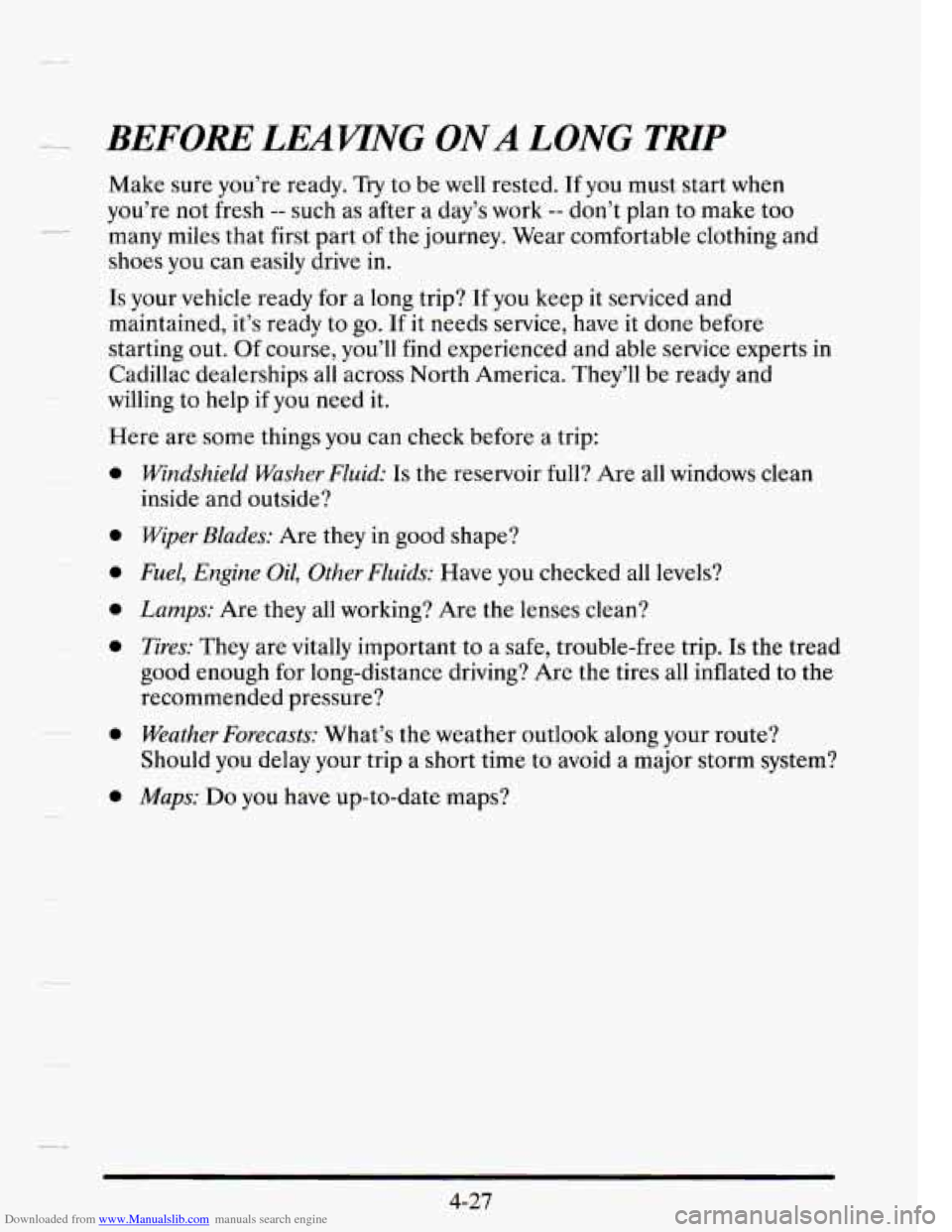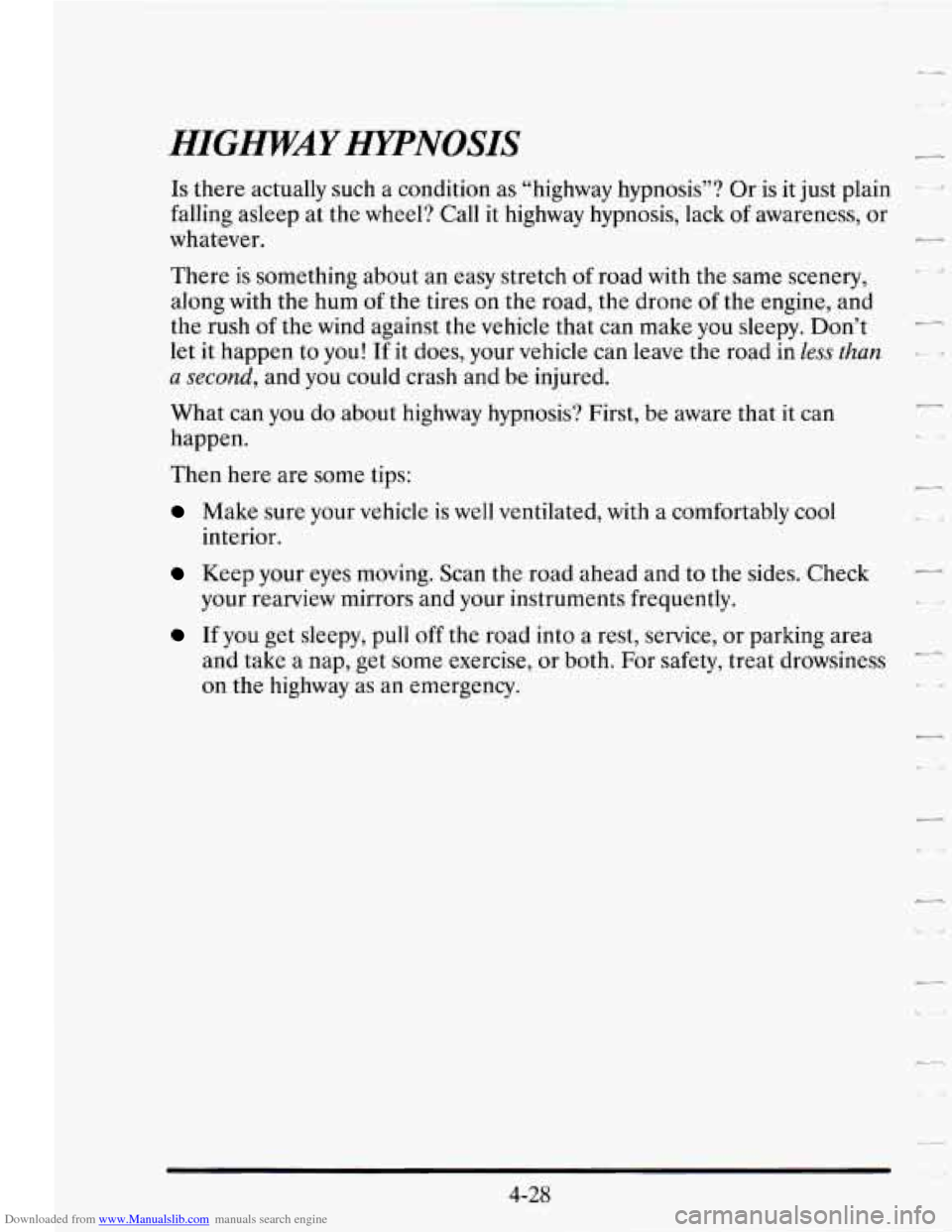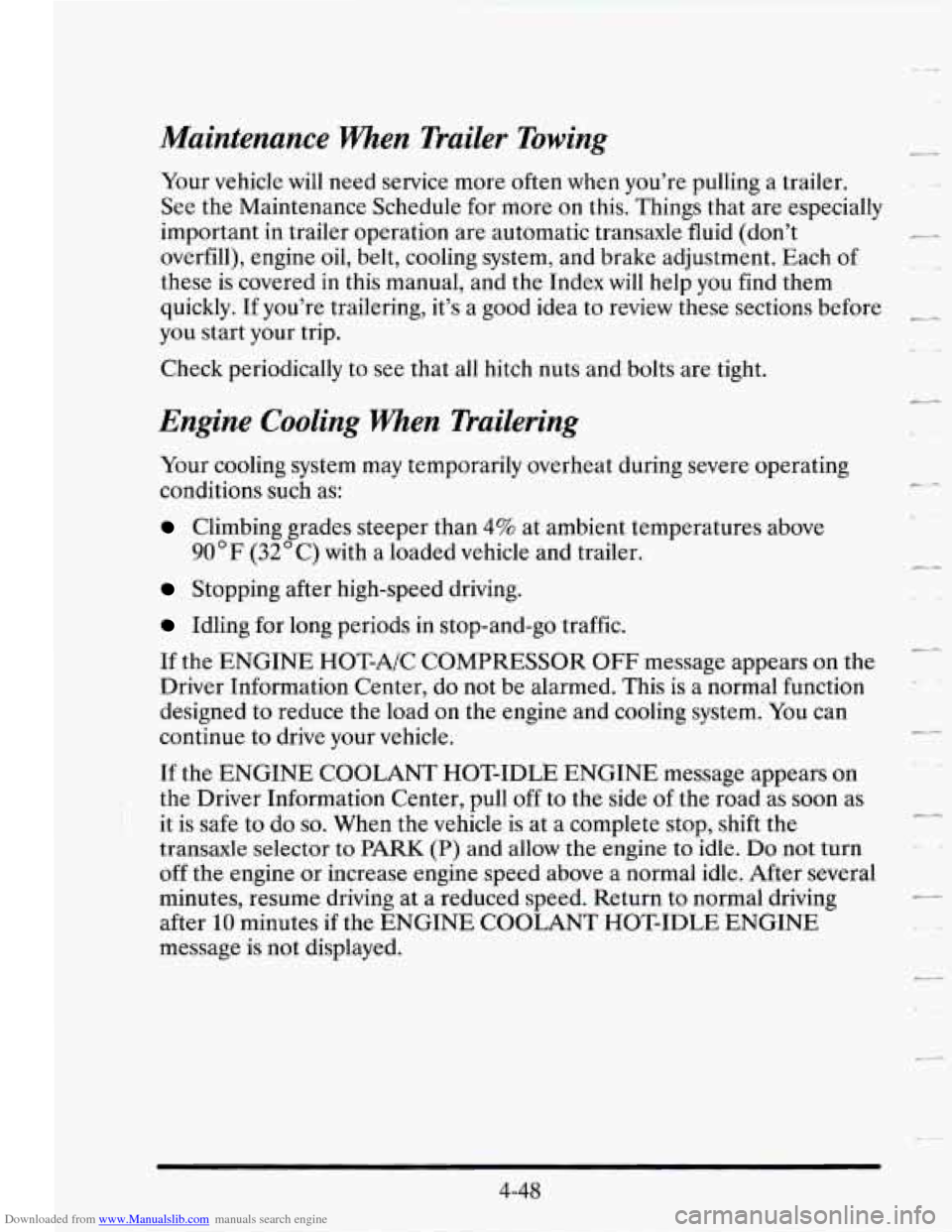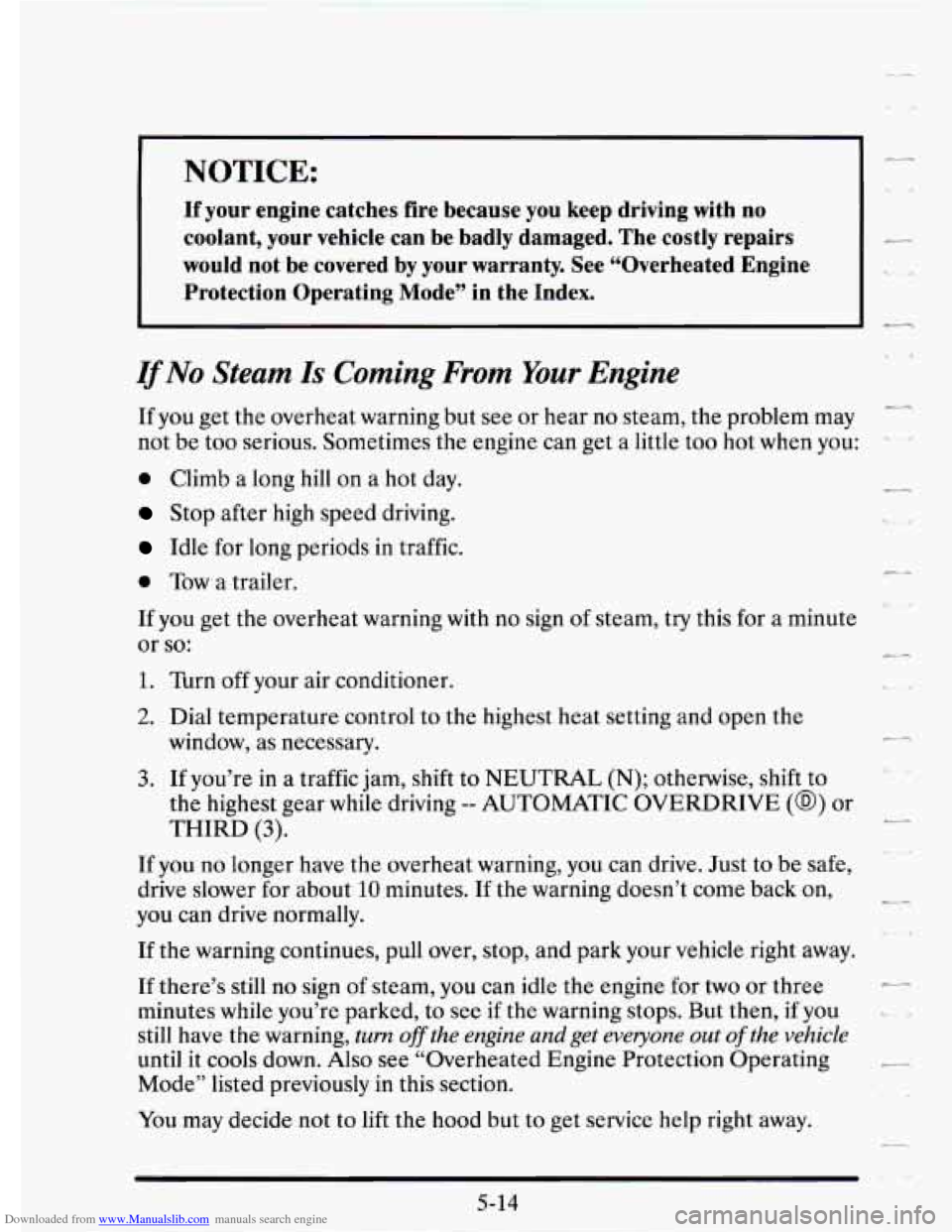Page 218 of 410

Downloaded from www.Manualslib.com manuals search engine - - .- BEFORE LEAVTNG ONA LONG TRlP
Make sure you’re ready. Try to be well rested. If you must start when
you’re not fresh
-- such as after a day’s work -- don’t plan to make too
many miles that first part
of the journey. Wear comfortable clothing and
shoes you can easily drive in.
Is your vehicle ready for a long trip? If you keep it serviced and
maintained, it’s ready to go.
If it needs service, have it done before
starting out.
Of course, you’ll find experienced and able service experts in
Cadillac dealerships all across North America. They’ll be ready and
willing to help
if you need it.
_1
Here are some things you can check before a trip:
0
0
0
0
0
0
0
Windshield Washer Fluid: Is the reservoir full? Are all windows clean
inside and outside?
Wiper Blades: Are they in good shape?
Fuel, Engine Oil, Other Fluids: Have you checked all levels?
Lamps: Are they all working? Are the lenses clean?
Tires: They are vitally important to a safe, trouble-free trip. Is the tread
good enough for long-distance driving? Are the tires all inflated to the
recommended pressure?
Weather Forecasts: What’s the weather outlook along your route?
Should you delay your trip a short time to avoid a major storm system?
Maps: Do you have up-to-date maps?
Page 219 of 410

Downloaded from www.Manualslib.com manuals search engine HIGAWKAY HYPNOSIS
Is there actually such a condition as “highway hypnosis”? Or is it just plain
falling asleep at the wheel? Call it highway hypnosis, lack
of awareness, or
whatever.
There is something about an easy stretch
of road with the same scenery,
along with the hum of the tires on the road, the drone of the engine, and
the rush
of the wind against the vehicle that can make you sleepy. Don’t
let it happen to you! If it does, your vehicle can leave the road in
less than
a second, and you could crash and be injured.
What can you do about highway hypnosis? First,
be aware that it can
happen.
Then here are some tips:
Make sure your vehicle is well ventilated, with a comfortably cool
interior.
Keep your eyes moving. Scan the road ahead and to the sides. Check
your rearview mirrors and your instruments frequently. .--.
..
If you get sleepy, pull off the road into a rest, service, or parking area
and take a nap, get some exercise, or both. For safety, treat drowsiness
on the highway as an emergency.
-
4-28
Page 239 of 410

Downloaded from www.Manualslib.com manuals search engine Adahtenance When Trailer Towing
Your vehicle will need service more often when you're pulling a trailer.
See the Maintenance Schedule for more
on this. Things that are especially
important in trailer operation are automatic transaxle fluid (don't
overfill), engine oil, belt, cooling system, and brake adjustment. Each
of
these is covered in this manual, and the Index will help you find them
quickly. If you're trailering, it's a good idea to review these sections before
you start your trip.
--
Check periodically to see that all hitch nuts and bolts are tight.
Engine Coding When Trailering
Your cooling system may temporarily overheat during severe operating
conditions such as:
Climbing grades steeper than 4% at ambient temperatures above
90°F (32" C) with a loaded vehicle and trailer.
Stopping after high-speed driving.
Idling for long periods in stop-and-go traffic.
If the ENGINE HOT-A/C COMPRESSOR OFF message appears on the
Driver Information Center, do
not be alarmed. This is a normal function
designed to reduce the load on the engine and cooling system. You can
continue to drive your vehicle.
If the ENGINE COOLANT HOT-IDLE ENGINE message appears on
the Driver Information Center, pull
off to the side of the road as soon as
it is safe to do
so. When the vehicle is at a complete stop, shift the
transaxle selector to PARK
(P) and allow the engine to idle. Do not turn
off the engine or increase engine speed above a normal idle. After several
minutes, resume driving at a reduced speed. Return
to normal driving
after
10 minutes if the ENGINE COOLANT HOT-IDLE ENGINE
message is not displayed.
4-48
Page 247 of 410
Downloaded from www.Manualslib.com manuals search engine 10. Don’t let the other end of the negative cable touch anything until the
next step. The other end
of the negative cable doesn’t go to the dead
battery. It goes to a heavy unpainted metal part on the engine of the
vehicle with the dead battery.
11. Now start the vehicle with the good battery and run the engine for
12. Try to start the vehicle with the dead battery.
awhile.
If it
won’t start after a few tries, it probably needs service.
Attach the
cable at least
18 inches (45 cm) away from the dead
battery, but not near engine parts that move. The electrical
connection is just as good there, but the chance of sparks getting back
to the battery is much less.
7
5-8
Page 249 of 410
Downloaded from www.Manualslib.com manuals search engine TOWING YOUR VEHICLE
Try to have a GM dealer or a professional towing service tow your
Cadillac. The usual towing equipment is:
A.
B.
C. Sling Type
Wheel Lift
Car Carrier
If your
adding
wheels, vehicle
has been changed or modified since it was factory-new by
aftermarket items like fog lamps, aero skirting or special tires and
these instructions and illustrations may not be correct.
Before you
do anything, turn on the hazard warning flashers.
When you call, tell the towing service:
0 That your vehicle cannot be towed from the front or rear with
sling-type equipment.
0 That your vehicle has front-wheel drive.
The make, model and year of your vehicle.
Whether you can still move the shift lever.
If there was an accident, what was damaged.
5-10
Page 250 of 410
Downloaded from www.Manualslib.com manuals search engine f k
P
!,
When the towing service arrives, let the tow operator know that this
manual contains detailed towing instructions and illustrations. The
operator may want to see them.
When your vehicle is being towed, have the ignition key off. The steering
wheel should be clamped in a straight-ahead position, with a clamping
device designed for towing service.
Do not use the vehicle's steering
column lock for this. The transaxle should be in
NEUTRAL (N) and the
parking brake released.
5-1 1
Page 253 of 410

Downloaded from www.Manualslib.com manuals search engine NOTICE:
-
If your engine catches fire because you keep driving with no
coolant, your vehicle can be badly damaged. The costly repairs
I-
would not be covered by your warranty. See “Overheated Engine
Protection Operating Mode” in the Index.
I‘
lj?Nu Steam Is Coming From Your Engine
If you get the overheat warning but see or hear no steam, the problem may
not be too serious. Sometimes the engine can get
a little too hot when you:
-
0 Climb a long hill on a hot day.
Stop after high speed driving.
Idle for long periods in traffic.
0 Tow a trailer.
If you get the overheat warning with no sign
of steam, try this for a minute
or
so:
1. Turn off your air conditioner.
2. Dial temperature control to the highest heat setting and open the
window, as necessary.
3. If you’re in a traffic jam, shift to NEUTRAL (N); otherwise, shift to
the highest gear while driving
-- AUTOMATIC OVERDRIVE (@) or
THIRD
(3). -
If you no longer have the overheat warning, you can drive. Just to be safe,
drive slower for about
10 minutes. If the warning doesn’t come back on,
you can drive normally.
L
c4
If the warning continues, pull over, stop, and park your vehicle right away.
If there’s still no sign of steam, you can idle the engine for two or three
minutes while you’re parked, to see if the warning stops. But then, if you
still have the warning,
turn ofithe engine and get everyone out of the vehicle
until it cools down. Also see “Overheated Engine Protection Operating
Mode” listed previously
in this section.
You may decide not to lift the hood but to get service help right away.
5-14
Page 255 of 410
Downloaded from www.Manualslib.com manuals search engine 13
a
If the coolant inside the coolant surge tank is boiling, don’t do anything
else until it cools down.
The coolant level should be visible inside the surge tank once the cap has
been removed.
If it isn’t, you may have a leak in the radiator hoses, heater
hoses, radiator, water pump or somewhere else in the cooling system.
a
I NOTICE: I R
Engine damage if you keep running your engine without coolant
isn’t covered
by your warranty. See “Overheated Engine
Protection Operating Mode” in
the Index.
If there seems to be no leak, with the engine on check to see if the electric
engine fans are running.
If the engine is overheating, both fans should be
running. If they aren’t, your vehicle needs service.
a
5- 16